
About Us
The Ocean Nutrient Biogeochemistry Group studies the role of nitrogenous and phosphorus nutrient cycling in sustaining marine primary production in the open ocean. Focus is given to the cycling and turnover of marine dissolved organic matter (DOM) including the carbon, nitrogen, and phosphorus containing components. A variety of scientific tools are incorporated in our research including chemical analyses of dissolved organic nitrogen and phosphorus, laboratory incubations of marine DOM turnover by microbes, and numerical simulation of marine carbon and nutrient cycles in tandem with the ocean circulation.
Faculty:
Robert T. Letscher
I am a marine biogeochemist with a primary research focus on the role of dissolved organic matter (DOM) cycling in the ocean’s biological carbon pump. The scientific questions I address are global in nature, seeking to uncover the mysteries of how the bioactive elements carbon, nitrogen, phosphorus, and oxygen cycle within the biological, chemical, and physical processes of the ocean. I employ a variety of approaches, combining field observations and laboratory experiments with numerical modeling of ocean biogeochemistry to arrive at new scientific insight. Examples include observations of dissolved organic nitrogen and phosphorus concentrations from the open ocean, laboratory experiments studying the biological and temperature controls on DOM degradation rates, and coding of new DOM cycling parameterizations and representation of variable C:N:P:O2:Fe stoichiometry in the ocean biogeochemistry component of Community Earth System Model. Ultimately, the newly added representations of ocean biogeochemistry in Earth System Models allows us to further refine our predictions of the interplay between ocean biology and climate into the future.
Formation of preformed nitrate anomalies at the subtropical ocean time-series sites
The subtropical oceans, the so-called “ocean deserts”, maintain surface ocean biological productivity and the biological carbon pump throughout the annual cycle, in excess of that which could be supported by known nutrient fluxes to the system. This represents a large gap in our scientific understanding and ability to predict future changes for regions that are responsible for nearly half of all ocean productivity. Nutrient, carbon, and oxygen cycling in these regions also exhibit significant anomalies with respect to their assumed proportions in ocean biomass and metabolisms. We investigated the formation rates of oxygen to nitrogen anomalies in the subtropical North Pacific and North Atlantic using time-series data and provide a quantitative analysis of the potentially contributing biological mechanisms. We found that biological production and consumption patterns of organic matter at proportions enriched in carbon and depleted in nutrient content, as well as bacterial uptake of nutrients at depth to consume nutrient depleted organic matter, can explain a portion of the observed anomalies and their formation rates. However >50% of the anomaly formation remains unexplained by these mechanisms. We conclude that vertically migrating phytoplankton, which traverse ~100–150 meters vertically in the upper ocean over days to acquire nutrients from waters at depth returning to the high light waters at the surface for photosynthesis, possess the required biogeochemical signature and abundance to likely explain the observed anomaly formation rates and sustain surface ocean productivity throughout the annual cycle. Phytoplankton vertical migrators, although rare and easily overlooked, may play a large role in subtropical ocean nutrient cycling and the biological carbon pump.
Modeling Picoplankton with the CESM
An ongoing project involves development of the Community Earth System Model and the Energy Exascale Earth System Model to include representation of the picoplankton within the ocean ecosystem component. I’m adding the Prochlorococcus, Synechococcus, and pico-eukaryotes to join the nano-plankton, diatoms, and diazotrophs phytoplankton groups in these climate models. Each group will have varying carbon, phosphorus, and iron quotas which will allow for a more realistic assessment of ocean biology’s role in and response to 21st century climate change.
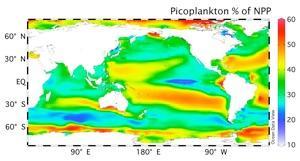
Dissolved organic phosphorus controls on marine nitrogen fixation and export production
A newly funded project with support from the NSF will significantly augment the global dataset of marine DON and DOP concentration measurements from the open ocean, in particular from under-sampled regions in the Indian Ocean, South Pacific, Southern Ocean, and South Atlantic Ocean basins. These new measurements will be assimilated in a state-of-the-art biogeochemical model to constrain the relative cycling rates of DOP and DON and to quantify the role of preferential DOP consumption by ocean biota. The new concentration measurements and diagnostic modeling will allow us to evaluate the quantitative role for regional variability in DOP consumption and recycling that supports export production and N2 fixation in the low latitude ocean.
Lateral Nutrient Transport to the Subtropical Gyres
A past study quantified the important role that the 3D ocean circulation and the lateral transfer of both organic and inorganic nutrients have on sustaining productivity in the remote “ocean deserts” of the central ocean gyres. The coupling of DON and DOP cycling model output with new tracer transport diagnostics from an offline ocean circulation model have allowed quantification of organic nutrient utilization rates in the subtropical gyres for the first time. Biological uptake of laterally supplied N and P dominates the nutrient budgets in the gyres and help explain seasonal carbon drawdown and nitrogen fixation patterns at the time-series sites. The results are published in the November 2016 issue of Nature Geoscience.
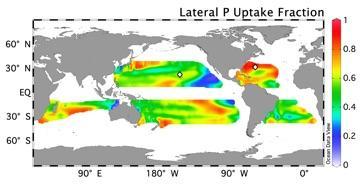
What Controls Marine DOC Production?
In a study published in Proceedings of the National Academy of Sciences, my colleagues Cristina Romera-Castillo, Dennis Hansell and I investigated the ultimate control on the biological production of marine dissolved organic carbon in the surface Atlantic ocean. We found that the introduction of new nitrogen, mostly in the form of nitrate, to the euphotic zone is the largest single determinant of marine DOC concentrations in the upper ocean. Any climate change related reductions in new nutrient input to the surface ocean will control the source term for this important component of the ocean carbon cycle.

Biogeochemical Modeling of Marine DOM
I’ve used data assimilation in a numerical modeling framework to investigate the many facets of DOM biogeochemistry. One study examined the differential recycling rates of dissolved organic phosphorus, nitrogen, and carbon and how this stoichiometry influences the spatial distribution of important global biogeochemical processes such as primary productivity, nitrogen fixation, and carbon export from the surface ocean. Dissolved organic phosphorus was found to have the fastest recycling rates with its cycling most important for shaping the spatial pattern of ocean productivity. See Letscher et al 2015 in Biogeociences and Letscher et al 2015 in Global Biogeochemical Cycles.
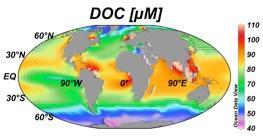
|
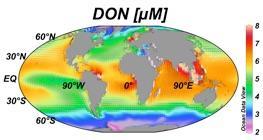
|
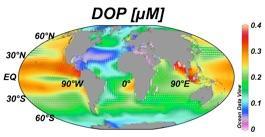
|
Global Dissolved Organic Nitrogen Biogeochemistry
One study examined a linkage between the marine nitrogen and carbon cycles by investigating the mechanisms by which dissolved organic nitrogen (DON) is recycled, shedding light on how DON can provide a nutrient source of nitrogen to sustain a portion of open ocean biological productivity. DON was found to be largely recalcitrant to biological consumption near the surface, instead requiring its transport to mid-depths where a small portion is remineralized releasing inorganic N back into the water column. See Letscher et al 2013 in Global Biogeochemical Cycles and a News & Views by Voss & Hietanen in Nature.

Tracing the Fate of Terrigenous DOM in the Arctic Ocean
The Arctic region as a whole is undergoing rapid change as a result of climate warming including an increasing transfer of land-derived organic material to the Arctic Ocean via rivers. Previous studies of mine investigated the fate of this terrestrial organic carbon and nitrogen upon delivery to the Siberian shelf seas including its rate of degradation and the consequences of these processes on dampening the Arctic Ocean’s capacity for absorbing atmospheric CO2 (in the case of carbon) or recycling nutrients to sustain local productivity (for nitrogen) See Letscher et al 2011; 2013 in Marine Chemistry.
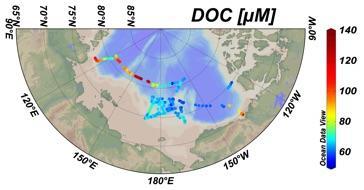
2022
Liang, Z., K. McCabe, S.E. Fawcett, H.J. Forrer, F. Hashihama, C. Jeandel, D. Marconi, H. Planquette, M.A. Saito, J.A. Sohm, R.K. Thomas, R.T. Letscher, & A.N. Knapp (2022), A global ocean dissolved organic phosphorus concentration database (DOPv2021), Scientific Data, 9, 772. Publisher's Version
R.T. Letscher, W.L. Wang, Z. Liang, & A.N. Knapp (2022), Regionally variable contribution ofdissolved organic phosphorus to marine annual net community production, Global Biogeochemical Cycles, 36(12), e2022GB007354. Publisher's Version
Liang, Z., R.T. Letscher, & A.N. Knapp (2022), Dissolved organic phosphorus concentrations in the surface ocean controlled by both phosphate and iron stress, Nature Geoscience, 15, 651-657. Publisher's Version
Martiny, A.C., G.I. Hagstrom, T. DeVries, R.T. Letscher, G.L. Britten, C.A. Garcia, E. Galbraith, D. Karl, S.A. Levin, M.W. Lomas, A.R. Moreno, D. Talmy, W. Wang, & K. Matsumoto (2022), Marine phytoplankton resilience may moderate oligotrophic ecosystem responses and biogeochemical feedbacks to climate change, Limnology & Oceanography, 9999, 1-12. Publisher's Version
Knapp, A.N., R.T. Letscher, & Z. Liang, (2022), DOP concentration observations from the global ocean between 1990 and 2021 (DOP N2 fixation and export production project), Biological and Chemical Oceanography Data Management Office (BCO-DMO), v3. doi :10.26008/1912/bco-dmo.855139.2. Publisher's Version
2021
Long, M.C., J.K. Moore, K. Lindsay, M. Levy, S.C. Doney, J.Y. Luo, K.M. Krumhardt, R.T. Letscher, M. Grover, & Z.T. Sylvester (2021), Simulations with the Marine Biogeochemistry Library (MARBL), J. Advances in Modeling Earth Systems, 13(12), e2021MS002647. Publisher's Version
2020
Howe, S., C. Miranda, K.L. Casciotti, C. Hayes, R.T. Letscher, & A.N. Knapp (2020), The dual isotopic composition of nitrate in the Gulf of Mexico and Florida Straits, JGR-Oceans, 125, e2020JC016047. Publisher's Version
2018
Letscher RT, Villareal TA. Vertically migrating phytoplankton drive seasonal formation of subsurface negative preformed nitrate anomalies in the subtropical North Pacific and North Atlantic. Biogeosciences Discussions [Internet]. 2018. Publisher's Version
Lonborg C, Alvarez-Salgado XA, Letscher RT, Hansell DA. Large stimulation of recalcitrant dissolved organic carbon degradation by increasing ocean temperatures. Frontiers in Marine Science [Internet]. 2018;4 :436. Publisher's Version
2017
Elliott S, Burrows S, Cameron-Smith P, Hoffman F, Hunke E, Jeffery N, Liu Y, Maltrud M, Ogunro O, Roekel LV, et al. Does Marine Surface Tension have Global Biogeography? Addition for the OCEANFILMS Package. Atmosphere [Internet]. 2017. Publisher's Version
Letscher RT, Moore JK. Modest net autotrophy in the oligotrophic ocean. Global Biogeochemical Cycles [Internet]. 2017;31 :699-708. Publisher's Version
Bourbonnais A, Letscher RT, Bange HW, Echevin V, Larkum J, Mohn J, Yoshida N, Altabet MA. N2O production and consumption from stable isotopic and concentration data in the Peruvian coastal upwelling system. Global Biogeochemical Cycles [Internet]. 2017;31 :678-698. Publisher's Version
2016
Letscher RT, Primeau F, Moore JK. Nutrient budgets in the subtropical ocean gyres dominated by lateral transport. Nature Geoscience [Internet]. 2016;9 :815-819. Publisher's Version
Romera-Castillo C, Letscher RT, Hansell DA. New nutrients exert fundamental control on DOC accumulation in the surface Atlantic Ocean. Proceedings of the National Academy of Sciences, USA [Internet]. 2016;113 (38) :10497-10502. Publisher's Version
2015
Letscher RT, Knapp AN, James A, Carlson CA, Santoro AE, Hansell DA. Microbial community composition and nitrogen availability influence DOC remineralization in the South Pacific Gyre. Marine Chemistry [Internet]. 2015;177 :325-334.Publisher's Version
Letscher RT, Moore JK. Preferential remineralization of dissolved organic phosphorus and non-Redfield DOM dynamics in the global ocean: Impacts on marine productivity, nitrogen fixation, and carbon export. Global Biogeochemical Cycles [Internet]. 2015;29 :325-340. Publisher's Version
Letscher RT, Moore JK, Teng YC, Primeau F. Variable C:N:P stoichiometry of marine dissolved organic matter cycling in the Community Earth System Model. Biogeosciences [Internet]. 2015;12 :209-221. Publisher's Version
Ogunro OO, Burrows SM, Elliott S, Frossard AA, Hoffman F, Letscher RT, Moore JK, Russell LM, Wang S, Wingenter OW. Global distribution and surface activity of macromolecules in offline simulations of marine organic chemistry. Biogeochemistry [Internet]. 2015;168 :1-32. Publisher's Version
2013
Letscher RT, Hansell DA, Carlson CA, Lumpkin R, Knapp AN. Dissolved organic nitrogen in the global surface ocean: Distribution and fate. Global Biogeochemical Cycles [Internet]. 2013;27 :141-153. Publisher's Version
Letscher RT, Hansell DA, Kadko D, Bates NR. Dissolved organic nitrogen dynamics in the Arctic Ocean. Marine Chemistry [Internet]. 2013;148 :1-9. Publisher's Version
2011
Letscher RT, Hansell DA, Kadko D. Rapid removal of terrigenous dissolved organic carbon over the Eurasian shelves of the Arctic Ocean. Marine Chemistry [Internet]. 2011;123 :78-87. Publisher's Version
Millero FJ, Huang F, Woosley RJ, Letscher RT, Hansell DA. Effect of dissolved organic carbon and alkalinity on the density of Arctic Ocean waters. Aquatic Geochemistry [Internet]. 2011;17 (4-5) :311-326. Publisher's Version
